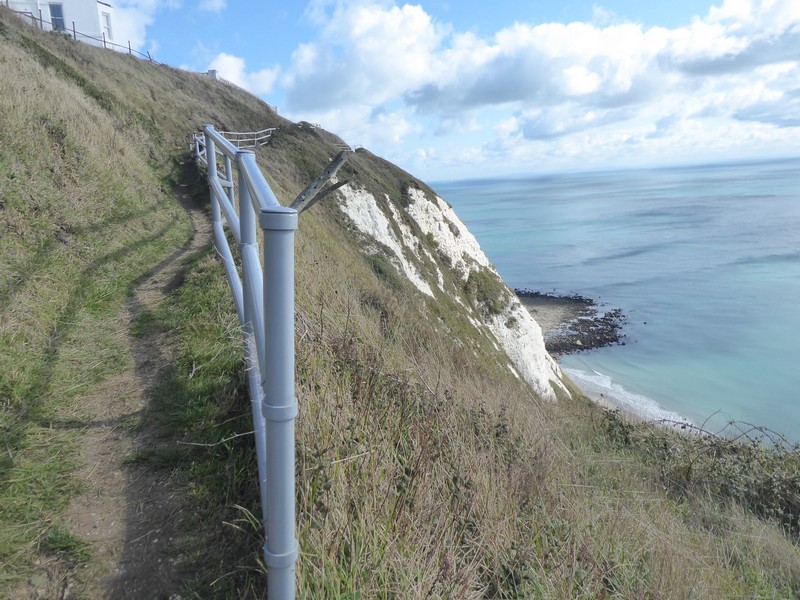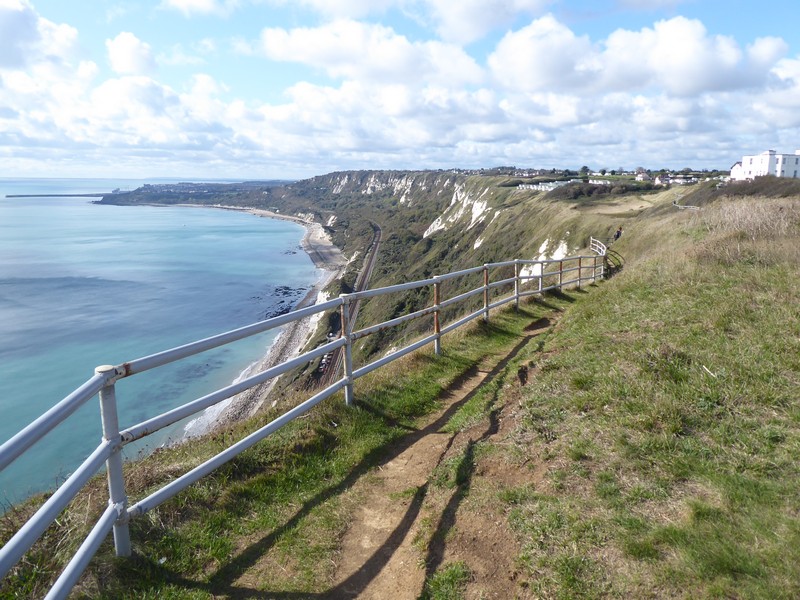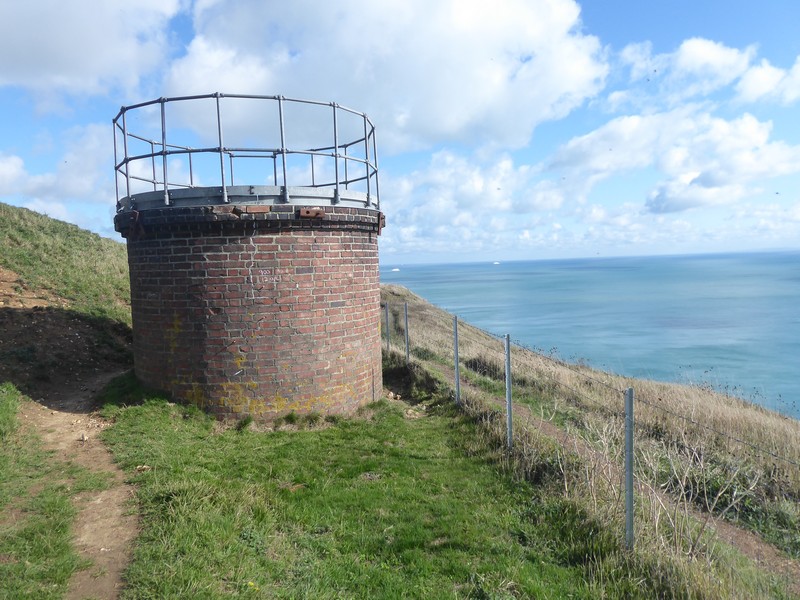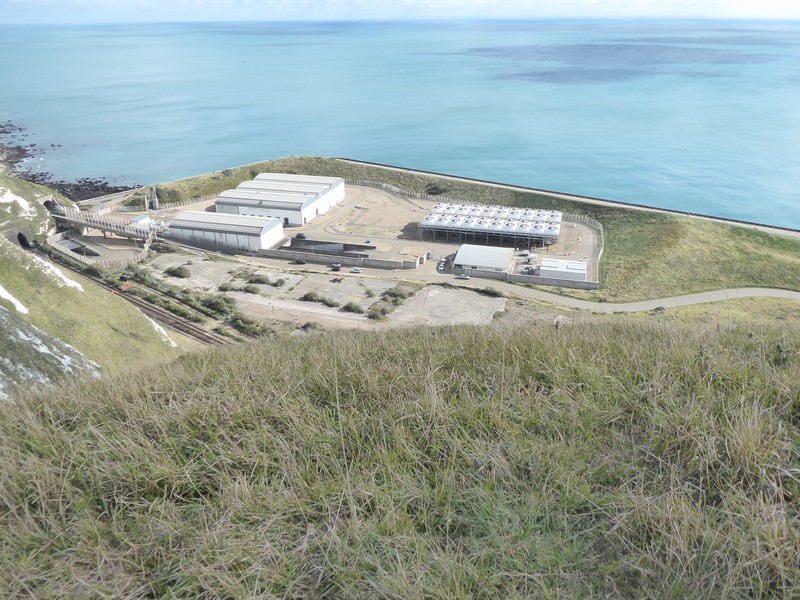I decided to reverse the direction of travel for today’s walk because of bus times, so I drove to and parked again at the Western Heights car park. I read some signs saying that the car park had been the centre of recent anti-social behaviour, although given the shifty nature of the people I saw in parked cars that early in the morning I have my suspicions what that could be! I Again I descended down towards the Railway Station, but stopped short at a bus stop and waited for the 07:51 #102 service towards Lydd. The bus journey seemed to take an age as the driver observed strict timetable waits at a number of stops.
I was glad to get off the bus in Dymchurch and equally pleased to have used my OS App, with free Bus Wi-Fi, to know which stop to get off. A short walk saw me on the large and sweeping shoreline of East Road. The bay curved back towards Folkestone and had a large modern sea wall guarding the low lying interior of Romney Marsh. I passed by a Martello Tower that had been totally transformed into a residential property with the walls all rendered and a large conservatory on the roof. When I reached the Hythe firing ranges I could have continued along the coast because there was no firing planned for today. However, I could see a large construction site around the Dymchurch Redoubt, complete with Heras fencing. I decided to stick to the perimeter road around the firing range.
As I entered Hythe town itself I was interested to walk along the Military canal; built between 1805 and 1809 as a strategic move against a possible French invasion during the Napoleonic Wars. The canal runs for 28 miles from Hastings to near Folkestone. I followed the canal till it came very close to the promenade which ran all the way into Folkestone. The sea front was busy with many people out walking, cycling, jogging and just chilling out at the number of beach side cafes.








As I reached Folkestone I passed by the old Folkestone Harbour railway station, closed to all traffic in 2009, in 2018 after a period of refurbishment it re-opened for pedestrian use and was hosting a small open-air market when I was there. I crossed over the old railway bridge and along the harbour walls with its fish sellers doing a brisk business. At Copt Point I climbed up steep steps towards the Martello Tower, which offered excellent views ahead across the expanse of wild partly forested chalk cliffs called The Warren. Here the Saxon Shore Way and England Coast Path joined the North Downs National Trail. I could have descended and walked along the base of the cliffs, but at some point I would need to climb up onto the cliff. I chose to do the climbing first as I planned to visit somewhere that was situated on the cliff-top path.
I had caught a glimpse of the Battle of Britain Memorial earlier that morning on the bus, so I was keen to take a closer look. Opened in 1993 on the site of the Capel Hill Battery (WWII), the Battle of Britain memorial contains a visitor centre, which was closed and a replica Spitfire and Hurricane. The open area contains a wall listing all those that fought in the Battle of Britain. Both yesterday and today a Spitfire flew over Dover and Folkestone performing aerial manoeuvres, I’m not sure if that was a planned thing, but it certainly brought home the message and the debt the county owes to “the few”.
I continued on across the Warren cliff top towards Abbots Cliff, here the coastal path split to a minor inland incursion avoiding the narrow path with exposed drops down to the railway line. Soon after I came to the Abbots Cliff Sound Mirror. A forerunner of radar, acoustic mirrors were built on the south and northeast coasts of England between about 1916 and the 1930s. The ‘listening ears’ were intended to provide early warning of incoming enemy aircraft.
The amazing physical features as I began the descent towards Dover were the ‘hogs-back’ chalk cliffs with grassy slopes and a narrow arête like ridge. At this point I could look down onto the Samphire Hoe Country Park, hemmed in by chalk cliffs and the sea it is an unusual site. Part of this area was created in the mid-19th century to enable the Folkestone – Dover railway to pass through. The real major construction project occurred with the building of the Channel Tunnel in 1993. Closeby the Channel Tunnel at some depth below the ground turns seaward heading out across the Channel. The spoil from the tunnel was used to create Samphire Hoe with landscaping to create a Nature Reserve. Access to the Hoe is via a tunnel from the nearby A20, with cars passing through the 200 -300m tunnel governed by traffic lights, a raised footpath allows pedestrians and cyclists to pass through to the Hoe. At the far end of the Samphire is a collection of buildings and a large cooling plant for the Tunnel itself.
I climbed up and over Round Down and descended to cross over the A20 to the small village of Aycliff on the outskirts of Dover. Here I found a shop open and stocked up on drinks for the drive home. I now had the task of climbing up from sea level to the top of Western Heights. Near to the car park I passed an early 12th century church built by Knights Templar.
A thoroughly enjoyable and fascinating walk.
























Distance today = 18 miles
Total distance = 6,372 miles

A nice writeup and pictures, and nice for me to see some familiar places. I lived in Hythe for a year while working on the construction of the Channel Tunnel in 1989-1990. It’ll be a long long time before I get to this area though – I’m still in Cumbria heading northwards!
LikeLike
Hi Paul, thanks welcome aboard. I have sent you a more comprehensive PM on your Blog.
LikeLike
Hi Alan. Interesting to read another description of a section I recently walked. I made the detour down into Samphire Hoe which gives some great views of the cliffs. We are at opposite ends of our journeys as I only started my round Britain walk in October but you are finishing where I am starting. Your site will be invaluable for when I reach Scotland. I was going well until Tier 4 hit today so I guess I am on pause for now sadly.
LikeLike
Hi Tony, thanks for subscribing to my blog, which I have reciprocated with your own, which I look forward to following.
Yes , unfortunate times. With Kent still in Tier 3, I have been unable to complete the remaining 15 miles to the East Sussex border Telford remains as a Tier 2 area. I have however continued to ‘stretch the legs’ with local walks until we return to something like normality. I have calculated that I have something like 16 more days until I complete my walk, so i’m not in any great rush to complete at the moment. I also hope to commemorate my completion with something unique which I will elaborate on in due course.
In the meantime enjoy these sections, as it does get harder the further you move away from home. Cheers for now.
LikeLike
I’m intrigued as to your completion celebrations Alan! It’d be nice to have a “UK coastal walker” reception committee at all our completions, and share some comradely spirit, but I guess Covid is seeing to that at the moment.
LikeLike